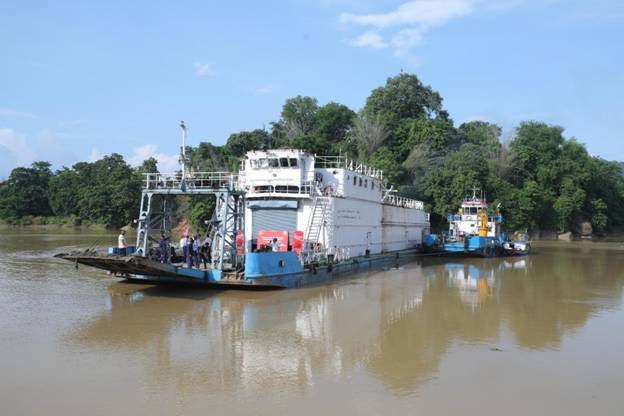Assam Launches Cargo Movement on Kopili River, Reviving Waterway Trade Route
Shri Sonowal noted the environmental and economic advantages of shifting freight from road to water.

- Country:
- India
In a monumental stride towards revitalising Assam’s riverine economy and bolstering sustainable transportation in Northeast India, the Kopili River (National Waterway-57) was officially operationalised on 1st August 2025 with the successful completion of its first-ever cargo trial run. This historic movement marks the resumption of intra-state waterborne freight transport in Assam after over a decade and promises to be a game-changer in regional logistics and economic empowerment.
The cargo vessel MV VV Giri, equipped with self-loading capabilities, carried 300 metric tonnes of cement from M/s Star Cement along a 300-kilometre journey from Govardhan Bridge in Chandrapur (Kamrup) to Hatsingimari in South Samara, navigating the Kopili River (NW-57) and Brahmaputra River (NW-2) in approximately 12 to 14 hours. The operationalisation of NW-57 now takes Assam’s total active waterway coverage to 1,168 kilometers, significantly enhancing the state’s inland water transport (IWT) network.
A Watershed Moment in Assam’s Transport History
Union Minister of Ports, Shipping & Waterways, Shri Sarbananda Sonowal, hailed the successful cargo trial as a watershed moment for Assam, asserting that it revives a crucial artery of trade and offers a sustainable, affordable, and efficient alternative to road-based logistics.
“With the operationalisation of NW-57 on River Kopili, we are not only reviving a lost artery of trade within the state but also creating an inland water transport system that is economical, efficient, and environmentally sustainable,” the Minister declared.
He emphasized that post-independence, Assam’s rich web of riverine trade routes remained largely neglected. The reactivation of NW-57 is part of a broader plan that includes ongoing cargo operations on other national waterways in the state — Brahmaputra (NW-2), Barak (NW-16), and Dhansiri (NW-31) — forming an interconnected network for multimodal transport solutions.
Eco-Friendly Logistics: A Smart, Sustainable Alternative
Shri Sonowal noted the environmental and economic advantages of shifting freight from road to water. Inland waterways reduce carbon emissions, alleviate road congestion, and lower overall logistics costs — crucial for improving supply chain efficiency in remote regions. He highlighted that the recent cargo movement on Kopili effectively replaced 23 truckloads of cement, illustrating the capacity and scalability of the IWT model.
“This is not just about logistics—it’s about smart, clean and sustainable transport,” he added.
Aligning with National Transport Visions: Gati Shakti and Maritime India Vision 2030
The operationalisation of NW-57 is aligned with flagship national initiatives such as PM Gati Shakti and the Maritime India Vision 2030, both of which aim to create integrated, multi-modal transport networks. These policies prioritise the revival of inland waterways to complement highways and rail networks, with a focus on green logistics and last-mile connectivity.
The Inland Waterways Authority of India (IWAI), under the Ministry of Ports, Shipping & Waterways, has been instrumental in unlocking navigational potential across Northeast India. The authority has steadily advanced projects on the Brahmaputra, Barak, Dhansiri, and now the Kopili, bringing neglected rivers into the mainstream of national logistics.
Strategic Significance of Kopili River
The Kopili River, stretching 46 kilometers under NW-57, flows as a tributary of the Brahmaputra and has historically served as a local trade artery. Its revival as an inland waterway not only connects strategic industrial and rural regions but also provides an essential economic lifeline to riverine communities who depend on accessible transport for livelihoods.
By reducing the dependency on road freight and offering a cost-effective logistics option, NW-57 is expected to stimulate economic growth in Chandrapur, Kamrup, South Samara, and surrounding areas, with ripple effects across the state’s trade, agriculture, and tourism sectors.
The Vision Ahead: From Trials to Transformation
Union Minister Sonowal stated that this successful cargo trial signals a new phase in Assam’s economic journey.
“The Kopili cargo movement is a symbol of the new Assam — connected, empowered, and aligned with India’s growth story. Waterways are not just a mode of transport; they are the arteries of regional prosperity,” he declared.
He added that the government is committed to scaling up cargo and passenger movement across all major rivers of Assam and transforming them into reliable, high-volume transport corridors. The IWT model will also open up opportunities for tourism, fisheries, and skill development, contributing to Assam’s self-reliance (Atmanirbhar Bharat) goals.
Empowering the Northeast through River-Based Infrastructure
Assam’s role as a strategic hub in the Act East Policy is being reinforced through such infrastructure milestones. With more rivers set to be revived under national waterways projects, the region is poised to become a gateway to Southeast Asian trade, while also addressing logistics bottlenecks in the hinterlands.
This initiative represents the government’s broader vision of a prosperous Northeast powered by clean transport, empowered communities, and resilient supply chains.










